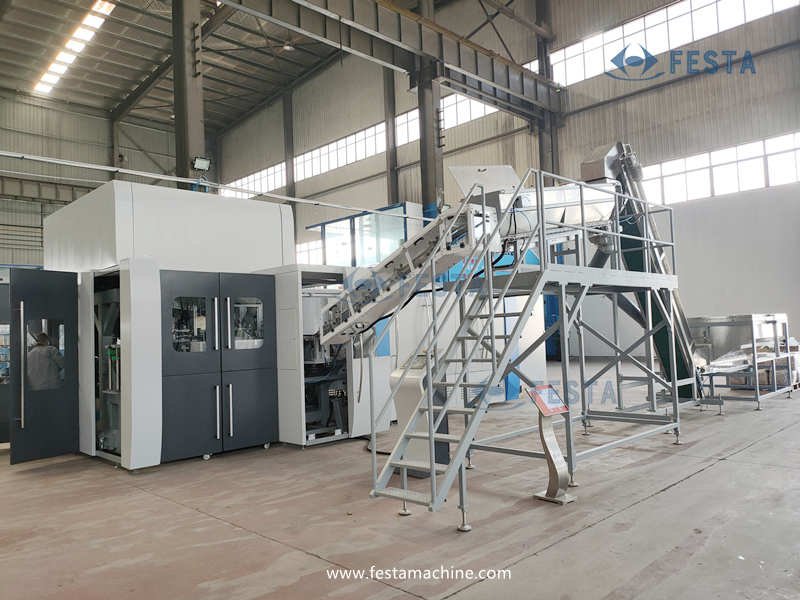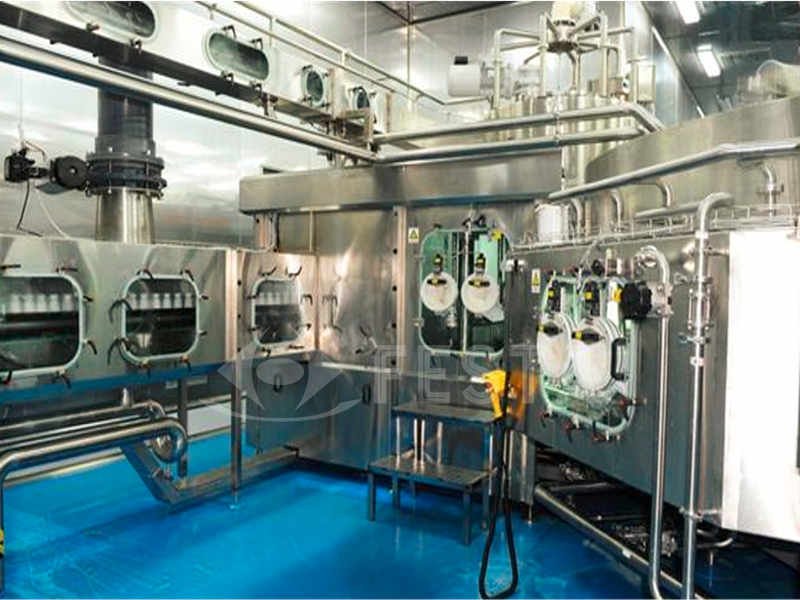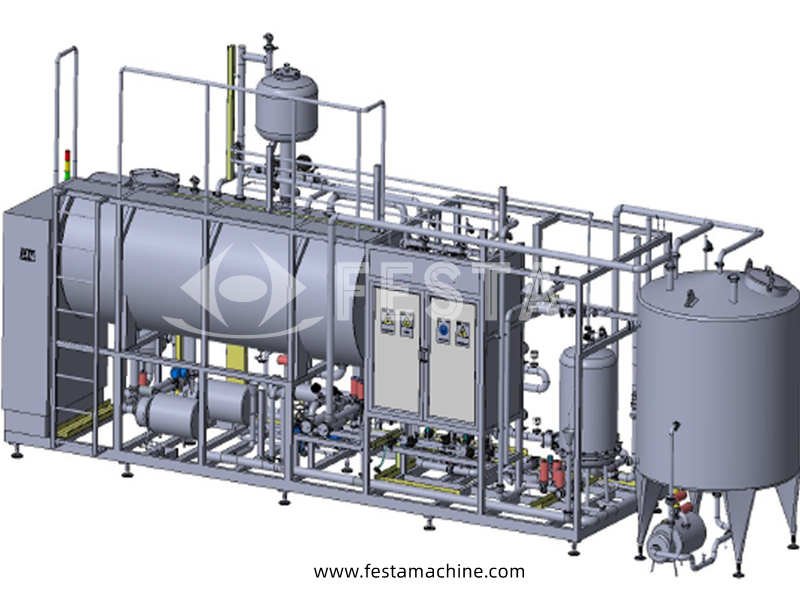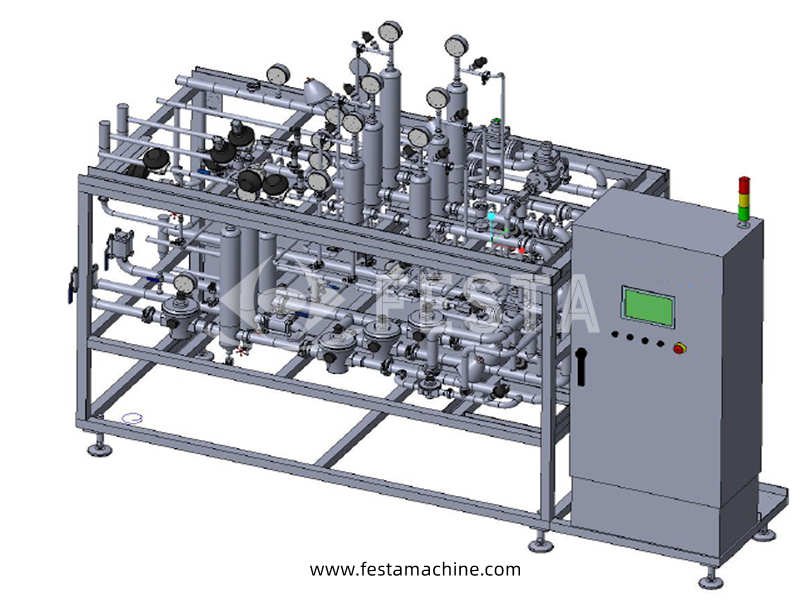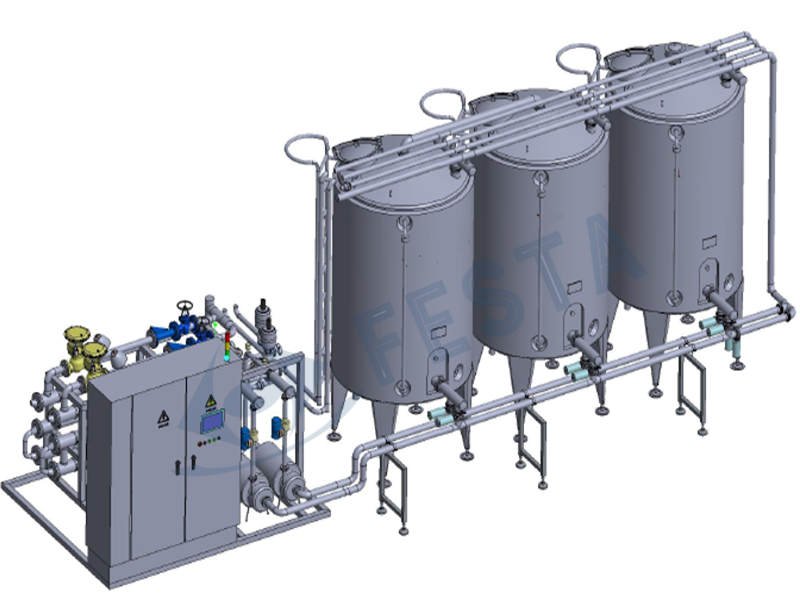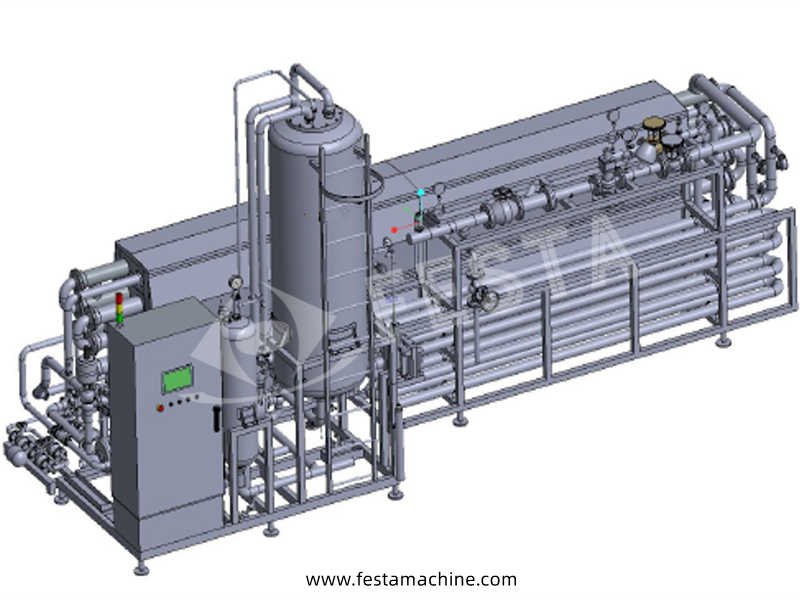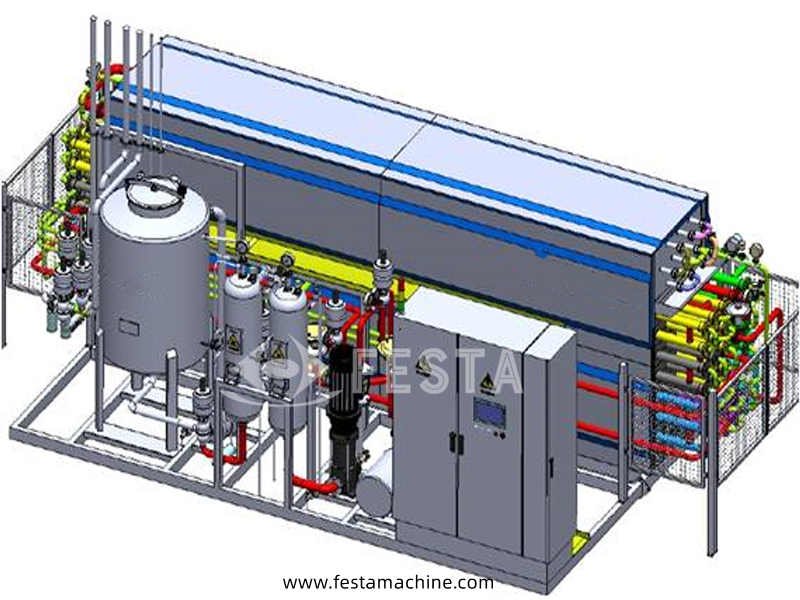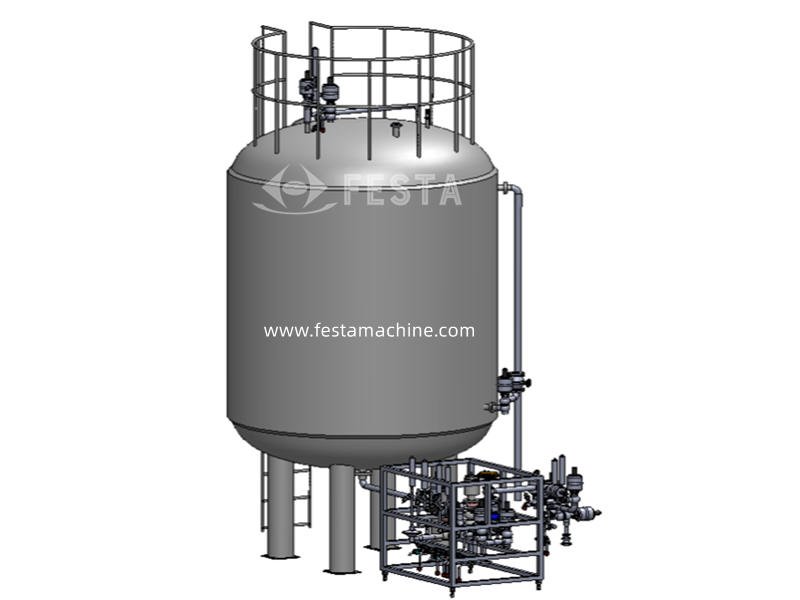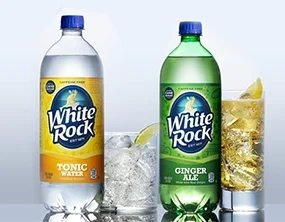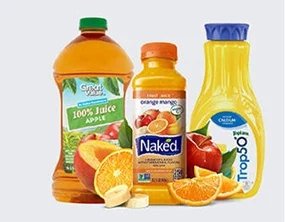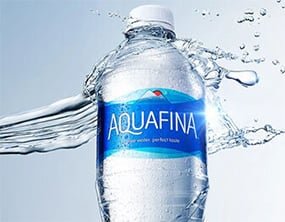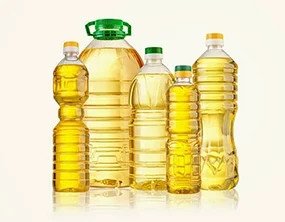One-stop Aseptic Filling Line Supplier
- Versatile filling line, suitable for all kinds of products
- Milk mixed drink, UHT milk.
- Fruit juice, Beverage containing granules
- Tea and Iced tea.
- Physical energy drink.
FESTA Aseptic Filling Line, Compact and Integrated.
Filling neutral drinks is always careful. Not only to ensure the safety of the product, on the other hand, the beverage is extremely sensitive to the addition of preservatives or hot filling. Aseptic filling can perfectly balance these two aspects, but only if it adopts professional microbial control technology and practical filling system. FESTA aseptic filling equipment can be sterilized by wet or dry method as needed, and the filling machine part adopts electronic Flowmeter, which has no contact and is more sanitary.
What’s the Key of Aseptic Filling Line?
- Sterile Bottle
- Sterile Cap
- Sterile Material
- Sterile Environment
- Sterile Machine
- Sterile Air
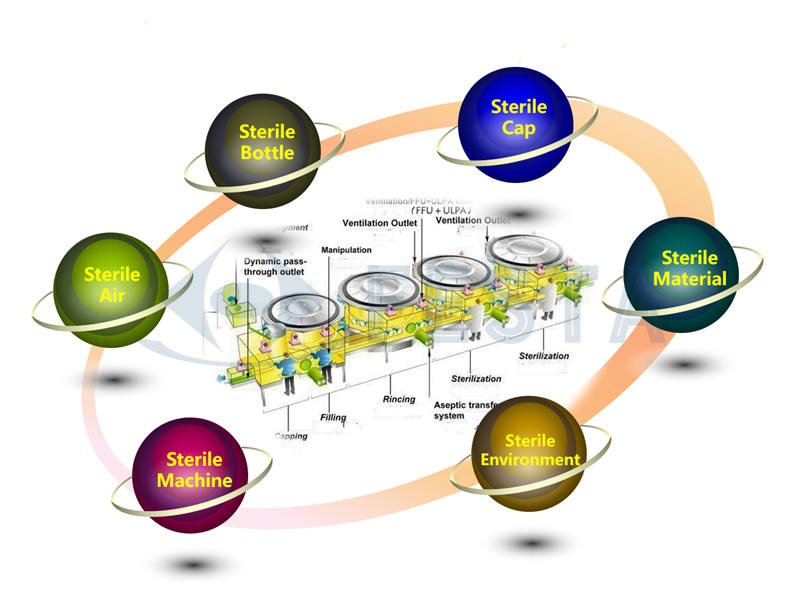
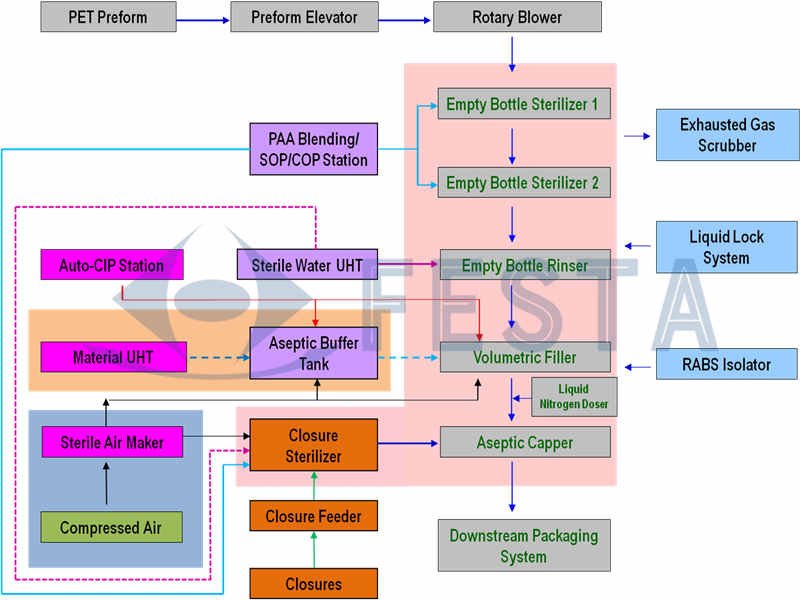
What is Aseptic Filling Process?
Aseptic processing is a unique processing technology, aseptic liquid products are filled into aseptic containers in an aseptic environment to produce products that can be preserved for a long time at room temperature.
Main Equipment of Aseptic Filling Line.
- Aseptic PET Bottle Filling System
- PAA blender/COP/SOP
- Sterile water preparation UHT/Sterile material preparation UHT
- De-aerator/Homogenizer
- Aseptic buffer tank/Sterile air maker
- Cap feeder & sterilizer/Cleaning room
- Manual COP station/CIP station/SIP station
- Central control system/Waste-gas scrubber
- Downstream packing system
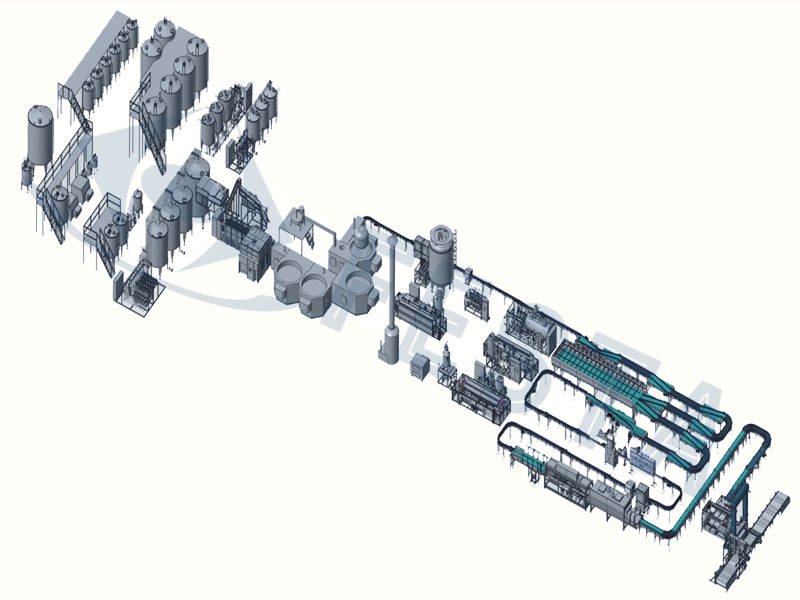
Bottle Blow Molding Machine
- Air cylinder stretching
- Servo type stretching
- Pre-blowing valve
- Blowing valve
- Air discharge valve
- Air back piping system
This machine is mainly used for blowing PET bottles in aseptic filling line. It has the advantages of reasonable structure, small footprint and good stability. It can produce PET bottles alone or form aseptic combiblock with aseptic filling machine.
Integrated:
- Sterilizer (PAA)
- Sterilizer (PAA)
- Rinser (Sterile water)
- Aseptic Filler
- Capper
Applicable for:
- High-acid products: juice, iced tea, sport drinks etc.
- Low-acid/neutral products: tea, milk, coffee milk, tea etc.
PAA Disinfectant Blender
Mixture of RO water and PAA disinfectant. Integrated functions of PAA disinfectant (Peracetic acid), Wetting agent blending, COP, SOP and fumigation (PAA + steam).
Using points: Bottle and cap sterilizing, isolator COP & fumigation, water/air piping SIP
Meet PAA demands of production: Concentration/Temperature/Output pressure
PAA concentration checking: Manual titration ( Input to HMI, PAA concentration will be rectified automatically)/Auto, on-line
Automatic COP Station
Function: For isolator cleaning
COP/SOP (PAA) integrated with PAA blending system
Alkaline and acid foam produced by alkaline and acid liquid mixing with vesicant (foaming agent)
- Alkaline foam: 3.0-3.5%
- Acid foam: 2.5-3.5%
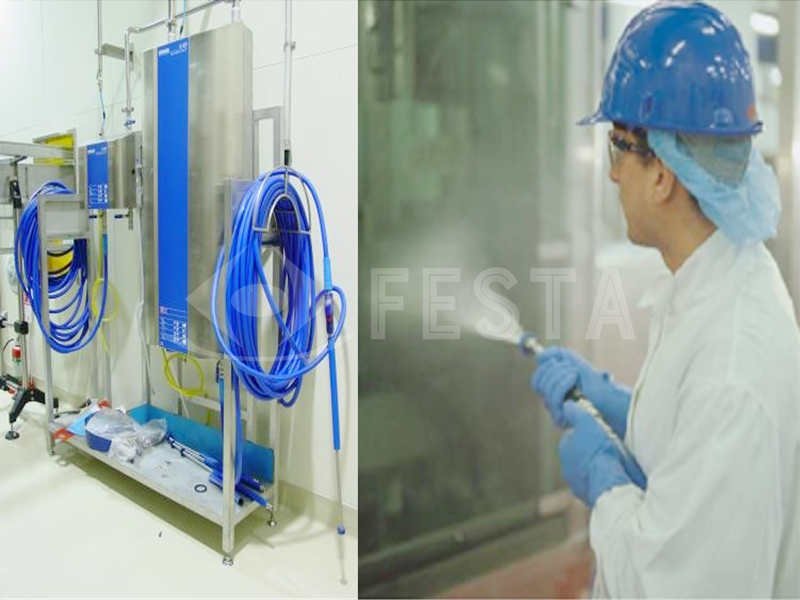
Sterile Air Preparation Maker
Function: Steam filtration, Instruments air preparation, Sterile air preparation
Composed of: Compressed air pre-filter, 2nd-stage anti-bacteria filter
Using points: Buffer tank, Filling tank, Cap sterilizer, Instruments in cleaning room
Sterile filter SIP way: steam
- Cap-drying filter –forward
- Back-pressure filter-backward
Filter: PARKE/PALL, Can also use nitrogen air as back-pressure air
CIP Station
CIP steps
- Single-step way: water/alkaline liquid/acid liquid
- Three-steps: water-alkaline/acid liquid-water
- Five-steps: water-alkaline liquid-water-acid liquid-water
CIP for: Filling machine, Aseptic buffer tank, Auto conductivity meter installed, auto-cleaning
Pure Steam SIP Station
Supply food-grade steam to:
- Steam SIP points, lubrication
- Steam barrier for filler
Main parameters
- Output steam pressure: 0.3Mpa
- Pure steam temperature: 140 ℃
- Heating steam pressure: 0.6mpa
Sterile Water UHT
Using points: Bottle & cap rinsing, Bottle neck rinsing, Isolator washing
- SIP way:
- Superheated water type SIP to UHT (pressure-resistance)
- Disinfectant type SIP to outlet pipe of UHT (non pressure-resistance)
Main parameters
- Softened water/RO water
- Inlet Temperature: 15-30 ℃
- Sterilizing Temperature: ≤140℃
- Holding time: 30-60s
- Outlet Temperature: 50-55℃
- Outlet Pressure: ≥ 3 Bar
Material UHT
Main parameter:
- Inlet temperature : 20-30℃
- Sterilizing Temperature: ≤142℃
- Holding Time: 5-60s (Adjustable)
- Outlet Temperature: 25-30 ℃
UHT and piping (pressure-resistance) SIP way: superheated water
De-aerator and homogenizer can be connected with UHT.
Aseptic Buffering Tank
- Function: buffer between UHT and filler
- Filler under CIP, UHT No stop
- UHT under CIP, Filler No stop
- Material inlet temperature: ≤30 ℃
- Buffer capacity:1.5-2.0hrs normally (depends on product category and user requirements)
- Cooling way: interlayer water cooling (RO water)
- SIP way: Food-grade pure steam
- Sterile air or N2 as pressure gas in buffer tank, 0.4-0.8Bar
- With aseptic “cross” valve group (GEA/SPX)
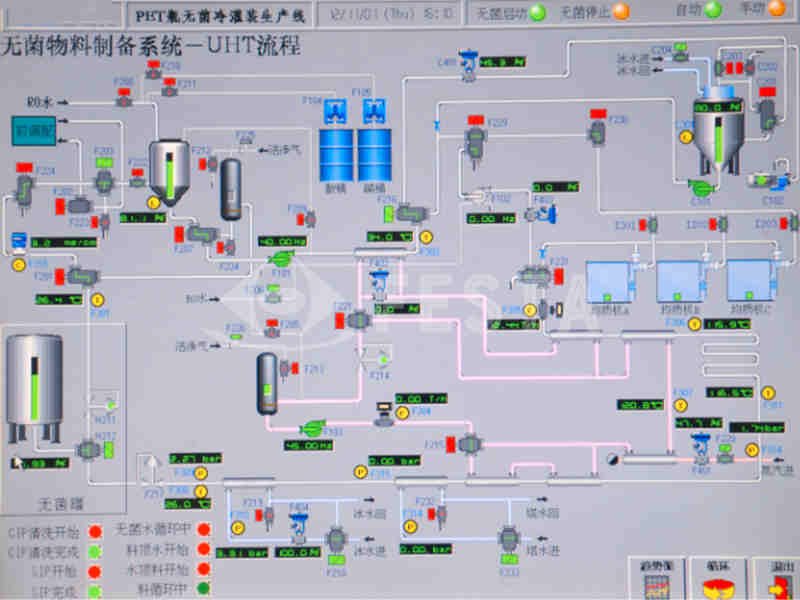
Central Control Center
All single machines dispatching center
All single machines monitoring center
Parameter, working condition, alarm record
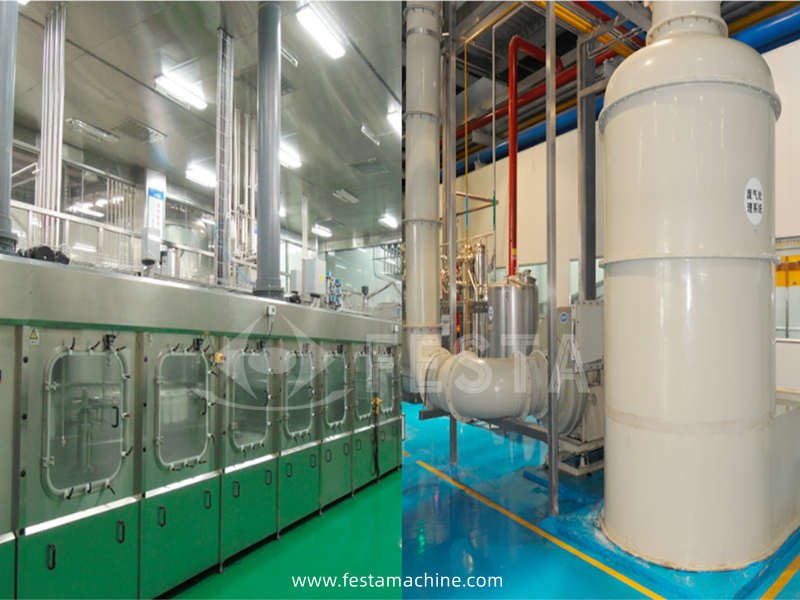
Waste-gas Scrubber
Isolator ventilation pipe connected with scrubber
Acidic gas with PAA will be exhausted after Na2S2O3 (Sodium Thiosulfate) neutralization
Start-up of Aseptic Filling
Cleaning and sterilization for the aseptic bloc is divided in 4 separate procedures. Total time: about 4.0 hrs
CIP (Cleaning In Place)=cleaning of the surfaces with contact to product
SIP (Sterilization In Place)=decontamination of the surfaces with contact to product
- Media:
- Steam (140 ℃, 0.3Mpa)
- Superheated water (e.g. 125-130℃, 20-30min)
- PAA disinfectant (e.g.2000-2500ppm, 60-65℃, 15min)
COP (Cleaning Off Place)=cleaning of the surfaces not with direct contact to product (mixture of steam and PAA)
- Isolator inner surfaces
SOP (Sterilization Off Place)=decontamination of the surfaces not with direct contact to product
- Isolator inner surfaces
- Media:
- Superheated water
- PAA disinfectant (e.g.1500-1700ppm, 25-35℃, 10-15min)
Depending in the production step, cleaning and/or sterilization procedures can be performed
All procedures fully automatic
Individual procedures can at some part be performed simultaneously
We also offer filling lines using other technologies
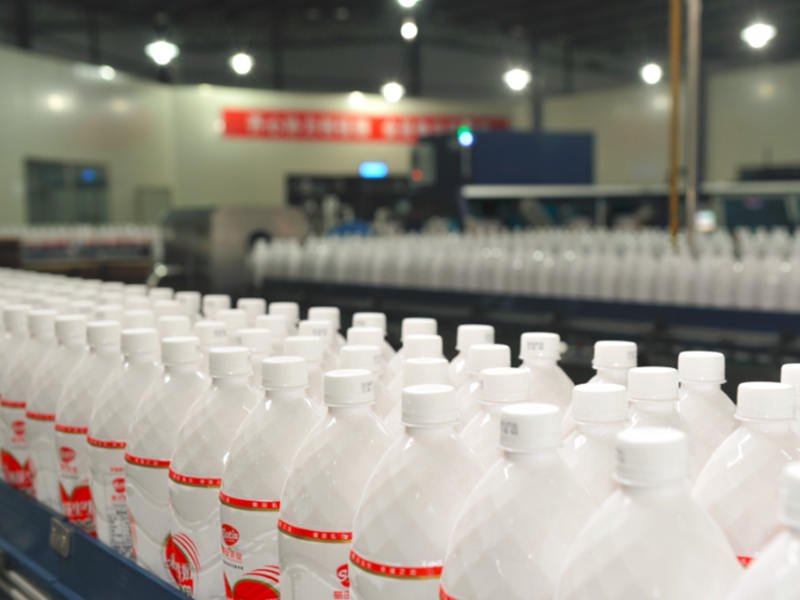
Visit Our Factory to See More
PET Bottle Aseptic Filling Line Manufacturer
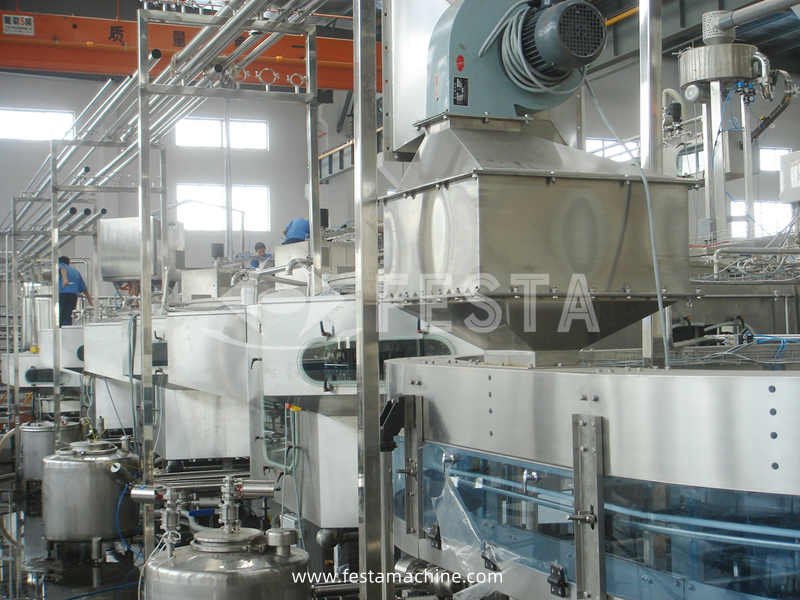
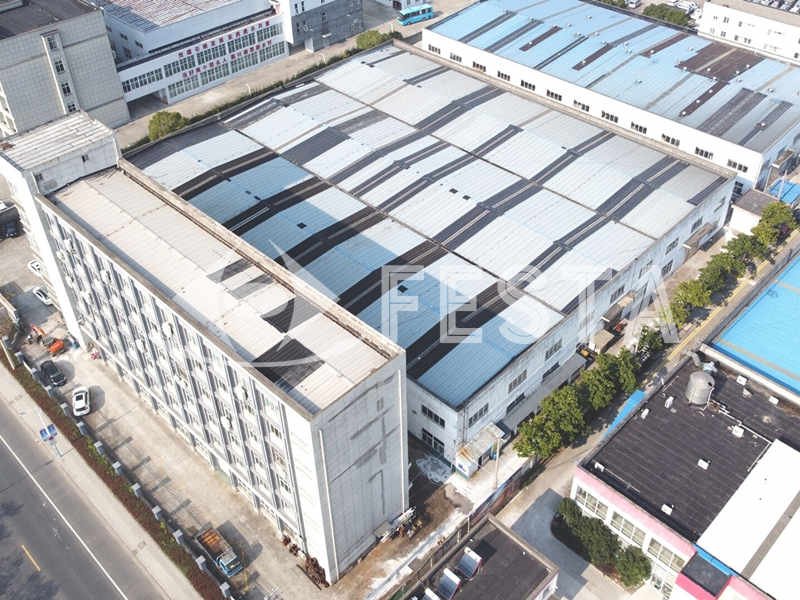
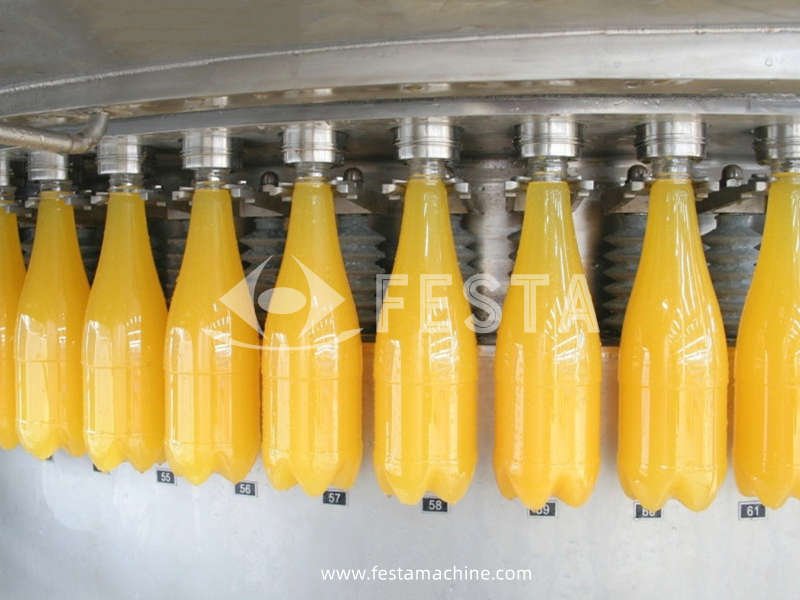
The Ultimate FAQ Guide for Aseptic Filling Line
Aseptic filling, also known as “universal filling”, can be produced in almost any beverage, whether neutral, acidic or highly acidic.
It is mainly defined according to the value of PH. For example, a PH value of less than 4.5 is called an acidic drink, and a value greater than 4.5 is a slightly acidic and neutral drink.
Aseptic packaging technology was born in the 1930s. Tetra Pak first used Tetra Pak aseptic packaging technology in commercial production in 1961. Now PET aseptic cold filling production line also uses aseptic space plus chemical disinfectant to sterilize to ensure that the whole filling process meets the sterile requirements.
Aseptic cold filling refers to the cold (room temperature) filling of beverage products under aseptic conditions, which is relative to the high temperature hot filling which is usually carried out under general conditions.
No, the parts on the equipment that may cause microbial contamination of the beverage remain sterile, so it is not necessary to add preservatives to the beverage.
Nowadays, asepsis in aseptic cold filling refers to commercial asepsis, not absolute asepsis.
No, the sterilization of aseptic cold filling is to sterilize the liquid and packing materials before filling, and there is no need for sterilization in the later stage.
Aseptic cold filling products are sterilized by instantaneous high temperature.
The sterilization retention time of general aseptic cold filling has the following retention time, which are: 5S, 10s, 15s, 20s, 25s, 30s, 35s.
The difference of sterilization retention time of aseptic cold filling is determined according to the characteristics of filling materials, and the sterilization retention time that needs to be selected is also different according to the characteristics of filling materials.
In order to achieve asepsis, the aseptic filling production line needs to be aseptic in the following aspects of the production line, that is: 1, the product is sterilized to aseptic; 2, the packaging materials and sealed containers should be aseptic; 3, the filling equipment should be aseptic; 4, the filling and sealing should be carried out in an aseptic environment; 5. The establishment, monitoring, recording and control of critical control points.
Aseptic filling is filled when the temperature is reduced to about 25℃ after UHT sterilization, while hot filling is filled when the temperature is reduced to 80-92℃ after UHT sterilization.
At present, chemical sterilization is mostly used in aseptic filling, that is, the packaging materials are sterilized by chemicals to ensure that the packaging materials are aseptic.
In aseptic filling production, there can be no reflux, otherwise the nutrition, flavor, color and other characteristics of the reflux will be changed after the second sterilization.
Aseptic filling uses aseptic tanks to store sterilized materials, and presses the materials in aseptic cans into the filling machine by positive pressure.
The aseptic tank itself is made of stainless steel, and before production, the aseptic tank will be sterilized by high temperature steam, and the tank will be fully closed after sterilization, so during production, the material will still exist in a sterile state after entering the aseptic tank.
The aseptic air of aseptic filling is mainly used for the use of key points, such as cap blow drying, sterilization, etc.
Aseptic water is mainly used to wash bottles and make them sterile.
Aseptic start-up needs to be done before production, so that all units of the equipment can achieve aseptic effect.
COP refers to cleaning the outside of the filling machine.
SOP refers to the sterilization of the outside of the equipment.
CIP refers to cleaning the interior of fluid equipment, such as filling machine, dispensing tank, etc.
SIP refers to the sterilization of the interior of the equipment, such as the internal SIP of the filling machine and the internal SIP of the aseptic water preparation machine.
COP mainly uses three kinds of media (acid, lye and water). The equipment is clean through the cleaning of acid, lye and hot water.
SOP mainly uses chemical peracetic acid steam heating to sterilize and disinfect the outside of the equipment, which is mainly used in filling equipment.
CIP mainly uses steam to heat acid and lye, then uses heated acid and lye to clean the inside of the equipment, and finally rinses it with water.
SIP is mainly sterilized inside the equipment through high temperature pure steam and high temperature hot water.
The longer the heat treatment time, the greater the effect on the quality of the beverage. Aseptic cold filling only uses UHT ultra-high temperature instantaneous sterilization, and the heat treatment time of the material is less than 30 seconds, while the sterilization method used in hot filling makes the material in a state of high temperature for a long time. It seriously affects the taste, color and the content of thermosensitive nutrients (such as vitamins), especially on vitamin beverages.
Hot filling method is only suitable for the production of high acid products, because the high acid environment itself has an inhibitory effect on microorganisms, hot filling for low acid beverages can not ensure the safety of the products, and the product defect rate is very high. For aseptic cold filling, because the whole filling process is carried out under aseptic conditions, the technological adaptability is very strong, and a wide range of products can be produced, including neutral tea drinks, dairy drinks, vegetable protein drinks and other beverages. You only need to adjust the pretreatment equipment properly.
The two filling methods have different requirements for PET bottles. Hot-filled PET bottles need to withstand a high temperature of 85℃ and 92℃ without deformation, which requires increasing the crystallinity of PET materials and limiting the production of induced stress during bottle blowing. It has the following characteristics: bottle wall thickness, need a high degree of crystallization to enhance thermal stability; clear bottle wall ribs to prevent thermal shrinkage; crystal bottle mouth is required, which greatly limits the degree of freedom of bottle design. Aseptic cold filling can use standard PET light bottle (maximum heat resistance temperature 60 ℃) and standard lid, which greatly reduces the cost of packaging materials, and the bottle type can be freely designed according to product characteristics for personalized packaging.
Compared with the product capacity of 500ml, the gram weight of hot-filled PET bottle is 28-32g, and that of aseptic filling PET bottle is 18-23g.
The bottleneck of hot filling is the special crystallization bottle neck, and the bottle neck of aseptic cold filling is the standard bottle neck.
The elongation of hot filling materials is high, while that of aseptic filling materials is standard.
The heat resistant temperature of hot filling preform is 85-92 ℃, and that of aseptic filling bottle preform is 60 ℃.
The hot filling PET bottle has thick wall and low oxygen permeability, while the aseptic filling PET bottle has thin wall and high oxygen permeability.
The caps needed for hot filling are high temperature resistant caps, while those for aseptic filling are standard caps.
The cost of hot-filled bottles and caps are higher than that of aseptic filling.
The bottle caps of aseptic filling generally adopt immersion sterilization, and the sterilization effect can be well ensured by controlling the soaking time.
No, our aseptic filling valve uses a unique filling valve, which will not produce secondary pollution in filling.
The air purification room is generally used to maintain the aseptic environment in PET aseptic cold filling production line. At present, the purification room used by food processing enterprises is developed from the pharmaceutical industry, the technical level has a unified standard, and the federal standard 209E is used in the United States. Air purification rooms can be divided into two types according to the control objects in the air: 1 those who control dust are called dust-free rooms (Industrial Clean Room); 2 those who control microorganisms are called aseptic rooms (Bio-Clean Room) to prevent microbial pollution. The main filling machine area of PET aseptic cold filling machine is required to be designed as a D100 aseptic room, and there is a 10,000-class purification room outside. The air cleanliness in the filling environment is ensured by the aseptic air filtration system in the purification room, so that the material will not be secondary contaminated by microorganisms suspended in the air. At the same time, the temperature and humidity of the purification room are controlled to ensure that the aseptic filling machine is always in good working condition.
In the whole environmental system, the operator is the biggest source of pollution, and the air clean room not only purifies the air, but also reduces the pollution caused by personnel: when the operators enter the ten thousand-level purification room, they have to go through spray sterilization; the design of the hundred-level purification room is small and practical, so that the operator can operate without destroying its aseptic environment, and the inner surface of the purification equipment can be cleaned and disinfected automatically.
Yes, FESTA’s material UHT has the advantage of saving energy consumption. During high temperature sterilization, our heat exchanger tube will recover part of the heat energy and reheat it.
Our material UHT has obvious advantages in material sterilization, this equipment has a variety of functions for customers to choose, for example, customers can switch sterilization retention time according to different production products; secondly, our material UHT can carry out material recovery and re-allocation according to customer needs.
Yes, in our material UHT equipment, there is the function of CIP self-cleaning, with this function, the time of aseptic startup can be greatly reduced.
If the material produced by the customer is flavored milk, then our material UHT needs to be cleaned by five steps, that is, water washing, acid washing, water washing, alkali washing and water washing.
Because our aseptic cold filling is filled with materials at room temperature, the cooling of material UHT equipment must meet the requirements, while in material UHT equipment, there are two kinds of cooling media, one is pre-cooling with tower water, and then cooling with ice water of about 7℃.
The advantage of this design is that it can reduce the use of ice water and greatly save energy consumption, and if ice water is directly used to cool down, it is easy to cause equipment damage.
As the sterilization temperature of material UHT is as high as 139℃, if 7℃ ice water is directly used to cool the temperature, the alternation of cold and heat is too fast, which will cause uneven pressure in the equipment and make the joint of the pipe vulnerable.
The sterilization and cooling process of material UHT must be stable, and how to ensure stability requires the use of proportional regulating valves to adjust the opening of steam inlet and the inlet of ice water and tower water to make it reach a balanced state.
Our material UHT adopts analog input and output to take the internal temperature parameters of the pipeline, so as to control the opening of the proportional control valve, which can be flexibly controlled according to the change of temperature.
Our material UHT if the heat exchanger tube is damaged, it can be detected, the main design principle is to warm up and cool down the medium through the heat exchanger tube and material contact, then we need to use the booster valve to control the cooling and heating pressure is greater than the pressure in the material pipeline, if the heat exchanger tube is damaged, then the pressure difference between the two will certainly be reduced, when reduced to a certain extent, then the equipment will alarm, indicating that the heat exchanger tube is damaged and needs to be serviced. need to be serviced.
No, if the heat exchanger tube is damaged and leaked at that time, the material will not be leaked because the medium pressure inside the heat exchanger tube is greater than the material pressure, which can ensure that the material in this shift will not be destroyed, and the equipment can be repaired after the end of production when the heat exchanger tube is damaged, which greatly saves the cost of aseptic start-up for customers.
Our material UHT will be equipped with a degassing device when the material will produce foam, to remove the foam during the sterilization process, to ensure that the material is free of foam when filling.
The degassing device in our material UHT uses vacuum to achieve this result. When the material passes through the material UHT degassing tank, a vacuum pump is used in the degassing tank unit, and this pump can set the vacuum pressure to remove the foam from the material in a stable manner.
Because the material UHT is in a high temperature state for a long time, so each pipeline interface, valve interface because not all stainless steel, need to use high temperature resistant material, and FESTA is a quality-oriented enterprise, so the selection of these key links are used when the international first-class brand, life is much higher than the domestic parts, so that the stability of the equipment can be well maintained.
First of all, our pre-blending is designed according to the characteristics of the material and the blending process provided by the customer.
Based on the advantage of FESTA’s experience in the aseptic line, we will give some reference advice with the customer’s material and can introduce relevant material process design units for the customer to choose.
The sugar level of the material directly determines the flow of the material, because aseptic lines are mostly fluid-based equipment, so the flow of the product determines the equipment selection.
We have two types of filtration, one is plate filtration and the other is diatomaceous earth filtration.
Plate filtration is relatively economical, but the disadvantage is that it is very troublesome to maintain, you need to disassemble the plate piece by piece, and then find the problem and install it again piece by piece, very time-consuming; while the advantage of diatomaceous earth filtration is that it is easier to maintain and clean, and it is possible to replace the diatomaceous earth after using for a period of time, but the disadvantage is that the cost is higher.
Our company is equipped with a sol-gel system, in which for the problem of sticky sol-gel, our company is equipped with a shearing system, which uses the stainless steel cutter in the sol-gel tank to cut evenly and then transfer to the mixing tank through the shearing pump to dissolve the pre-blending, which will not cause blockage in the pipeline.
Generally steam heating is used.
In the former deployment, steam heating needs to be equipped with steam pressure reducing valve and shut-off valve, so that before each heating, the condensate in the pipeline needs to be drained and the opening of the shut-off valve needs to be controlled for smooth heating.
Generally the material is filtered before entering the blending tank, and the filtration is done by means of a mesh bag filter.
The aperture of mesh bag filtration is selected according to the characteristics of the material, and the life of mesh bag filtration is relatively long and easy to clean.
Conventional process water into the sterile water equipment, sterile water equipment in a closed state, and then use high-temperature steam to heat the process water to a high temperature, to maintain a period of time, that is, to reach the sterile state.
In aseptic water UHT equipment, there are two types of media for cooling, one is pre-cooling with tower water first, followed by cooling with ice water at about 7°C.
The advantage of this design is that the use of ice water can reduce the amount of ice water, which greatly saves on energy consumption, and if ice water is used directly to cool down, it is easy to cause damage to the equipment.
As sterile water UHT sterilization temperature up to about 139 ° C, if the direct use of 7 ° C ice water cooling, the alternation of hot and cold too fast, will cause uneven pressure in the equipment, resulting in easy damage at the pipeline interface.
Sterilization and cooling process of sterile water UHT, must ensure stability, and how to ensure stability requires the use of proportional adjustment valve to adjust the opening of the steam inlet and adjust the opening of the ice water, tower water inlet, so that it reaches a balanced state.

